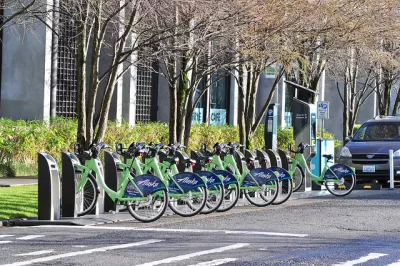While bikeshare garners a lot of attention from the white and wealthy, it is a less obvious choice for low-income communities. Difficulties include weather, time constraints, and overall demand for non-auto modes.

Bikeshare faces a demographic crisis. Often a success where locals are wealthy, it has failed to take root in poorer communities of color, where a greater proportion of bike commuters live. "This is a glaring issue, critics say, especially in places where public money is being used to help bike share systems break even."
Despite efforts by cities like Philadelphia to locate bikeshare stations in poor neighborhoods and allow payment by cash, the system has yet to catch on fully.
Reasons for this disparity coincide with more general transportation challenges low-income neighborhoods face. They include:
- Low-income bike commuters don't necessarily prefer biking, they just can't afford a car.
- Bikeshare is only reliable when the racks contain bikes: if they're all being used, it could mean showing up to work late or not at all.
- In a similar vein, cycling to work (though possible) is less attractive in bad weather. Wealthy bikeshare users could probably choose to drive, but a low-income person solely dependent on bikeshare could not.
FULL STORY: Bike share users are mostly rich and white. Here's why that's hard to change.

Manufactured Crisis: Losing the Nation’s Largest Source of Unsubsidized Affordable Housing
Manufactured housing communities have long been an affordable housing option for millions of people living in the U.S., but that affordability is disappearing rapidly. How did we get here?

Americans May Be Stuck — But Why?
Americans are moving a lot less than they once did, and that is a problem. While Yoni Applebaum, in his highly-publicized article Stuck, gets the reasons badly wrong, it's still important to ask: why are we moving so much less than before?

Using Old Oil and Gas Wells for Green Energy Storage
Penn State researchers have found that repurposing abandoned oil and gas wells for geothermal-assisted compressed-air energy storage can boost efficiency, reduce environmental risks, and support clean energy and job transitions.

Minneapolis Bans Rent-Setting Software
Four cities have enacted restrictions on algorithmic software that can inflate rent costs.

Oakland to Add 244 New EV Chargers
Oakland plans to launch its new charging network at eight locations by the end of 2025.

Jane Goodall Inspires with Message of Hope, Resilience, and Environmental Action
Speaking in Pasadena, Jane Goodall offered a hopeful and inspirational message, urging global compassion, environmental responsibility, and the power of individual action to shape a better future.
Urban Design for Planners 1: Software Tools
This six-course series explores essential urban design concepts using open source software and equips planners with the tools they need to participate fully in the urban design process.
Planning for Universal Design
Learn the tools for implementing Universal Design in planning regulations.
Heyer Gruel & Associates PA
City of Moreno Valley
Institute for Housing and Urban Development Studies (IHS)
City of Grandview
Harvard GSD Executive Education
Salt Lake City
NYU Wagner Graduate School of Public Service
City of Cambridge, Maryland





























